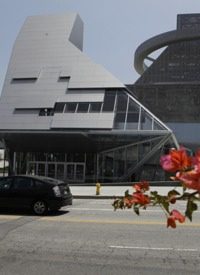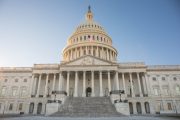
California may be broke, and politicians in the nation’s capital may be drowning in trillion-dollar deficits, but none of that has turned off the spending spigot in every level of government: county, city, state and federal.
Los Angeles just unveiled the "costliest school in the nation" at $578 million — the Robert F. Kennedy Community Schools — a K-12 mega-complex, referred to as "the crème de la crème of Taj Mahal schools," in a piece by Associated Press reporter Christina Hoag. The Los Angeles Unified School District, never exactly a model of academic superiority with its 50-percent dropout rate, nevertheless intends for the pretentious palace to serve as a "showpiece for the community." Too bad the pupils who populate the classrooms won’t serve as showpieces of American scholarship.
Not to be outdone, the East Coast is ratcheting up the competition. The State of Delaware has taken its share of Barack Obama’s $4.35 billion education reform movement, "Race to the Top," and turned it toward a race to the public trough. Delaware’s Capital School District has launched a scheme to pay parents a stipend if they participate in designated school events! The idea apparently is so audacious that it is catching on in the "Delamarva" area and beyond.
The term "Delmarva" is frequently used here to cover three states — Delaware, Maryland, and Virginia, as well as Washington, D.C., which is sandwiched between them. "In March," states the article, "Delaware and Tennessee were the only states to receive first-round funding [for Obama’s "Race to the Top" resources], winning a collective $600 million." Delaware scored highest among the 41 applicants vying for the federal, stimulus-based program, which aims "to encourage states to turn around failing schools, boost student achievement and reward teachers who excel" — just like all the other school-reform pot-shots before it: the "National Defense Education Act" (Eisenhower administration), the "Great Society" agenda-inspired Elementary and Secondary Education Act and National Teachers Corps (Johnson administration), the "Effective-Schools Movement" (Carter and Reagan administrations), "The Education Reform Act" (Reagan administration) "America 2000" (George H. W. Bush administration), "Goals 2000: Educate America Act" (Clinton administration), the "Comprehensive School Reform (CSR)" program, and finally the "No Child Left Behind Act" (George W. Bush administration). Increasing parental involvement is a must-have component of every such initiative, and Delaware’s Governor Jack Markell is championing the pay-parents idea.
Schools today are all about showmanship and commercialization, mostly to garner long-lost parental and other taxpayer support, as well as to keep kids institutionalized, where they can be watched instead of out doing Lord-knows-what. Toward these ends, Los Angeles schools are among the costliest, according to the AP story — $377 million for the Edward R. Roybal Learning Center in 2008, and "$232 million for the Visual and Performing Arts High School that debuted in 2009." But California is not alone, and it is noteworthy that "some of the most expensive schools are found in low-performing districts" — New York City has a $235 million campus and New Brunswick, New Jersey, opened a $185 million high school last January. AP reporter Christina Hoag points out that dozens of the nation’s schools, in fact, have surpassed the $100 million mark, "with amenities including atriums, orchestra-pit auditoriums, food courts, even bamboo nooks."
But the dirty little secret that has done in the schools, regardless of any extravagance, was inadvertently broached in the AP article with this telling remark: "Schools have long plied parents with offers of free food or back-to-school supplies."
What no one is saying is that parental involvement is wanted only when it suits the school’s own interests. Educrats don’t want parents who interfere; help with homework; or question policies, programs and directives. Parents who desire input into curriculum, for example, or an opportunity to review a controversial textbook, assessment, or survey, or who just want to sit in on their child’s class — either to monitor their young upstart’s conduct or just to get a sense of the selected course or school environment: Such busybodies are rudely vanquished, sometimes with police escort, as happened in Broken Arrow, Oklahoma.
In a landmark 1987 case (Mozert v. Hawkins County Public Schools, denigrated by the media as the "Scopes II trial"), the Sixth Circuit Court of Appeals ruled that parents’ rights to control the education of their children stop at the schoolhouse door. Michael Farris (1983 co-founder and a president of the Home School Legal Defense Association) litigated the case. He clarifies the court’s position that has since led to the overwhelming success of HSLDA: "Once a child has been submitted to the public schools for his education, parents lose all ability to control the course of instruction." Despite considerable attention in all the major papers and television newscasts, petition for review by the U.S. Supreme Court was denied, citing a lack of legal merit (translation: "not worth the trouble in an overly contentious political environment").
Truth was, though, parents were getting bad vibrations from educators long before 1987, especially as courses like sex education and social studies increasingly drove a wedge between youngsters and their elders. Statistics as early as the late 1970s were showing that by the time a child hit the fourth grade, parents tended to lose interest in their schools. They would chauffeur their kids between activities (which can take up every spare moment of discretionary time), and they would reluctantly purchase all the latest electronic gadgetry and "hooker-chic" clothing to assure their youngsters fit in with the rest of the student body. But challenging a school on any issue whatsoever became verboten, and parents worried that miffed school officials might take their angst out on their children.
Moreover, it was clear that educators only wanted to see other grown-up faces as long as their presence was limited to serving the cookies and the punch, and to cheerlead for whatever experts deemed appropriate, but if parents and "concerned citizens" had anything else to say, educrats didn’t want to hear it.
The other message parents absorbed was that the job of parenting is too daunting for anyone but an expert. Beginning with the Effective Schools Movement, the push was on by government at all levels for ever-younger Early Childhood and pre-kindergarten programs, as well as for employer-subsidized day care. Today, they want every toddler screened for emotional "disorders," too.
Sadly, all the pricey approaches for reforming and enhancing education, regardless of political party or administration, have fallen flat. None have appreciably raised standards, energized parents, or even made school more appealing to youngsters. As fast as new facilities are erected, pupils vandalize them and heap contempt upon the millions — now billions — shelled out for their alleged benefit. The "Taj Mahal" schools will be no different.
The absurdity of schooling in America, so clear from the dual stories above, both published the week prior to the beginning of yet another school year, would be laughable if they didn’t reflect such desperation. There is, of course, a way to reform education and make it stick, just as there is an answer to out-of-control kids and sordid entertainment choices that are thrust at children daily. But our nation’s leaders don’t want this kind of reality check; they know they have squandered their credibility and lost too much citizen support to solicit their help now.
Thus, Barack Obama’s $4.35 Race to the Trough is sure to be doubled or tripled in successive administrations.
______________
Beverly K. Eakman is a former educator and retired federal employee who served as speechwriter for the heads of three government agencies as well as editor-in-chief of NASA’s newspaper (Johnson Space Center). Today, she is a Washington, DC-based freelance writer and columnist, the author of five books, and a frequent keynote speaker on the lecture circuit. Her most recent book is Walking Targets: How Our Psychologized Classrooms Are Producing a Nation of Sitting Ducks (Midnight Whistler Publishers).
Photo of Robert F. Kennedy Community Schools: AP Images



